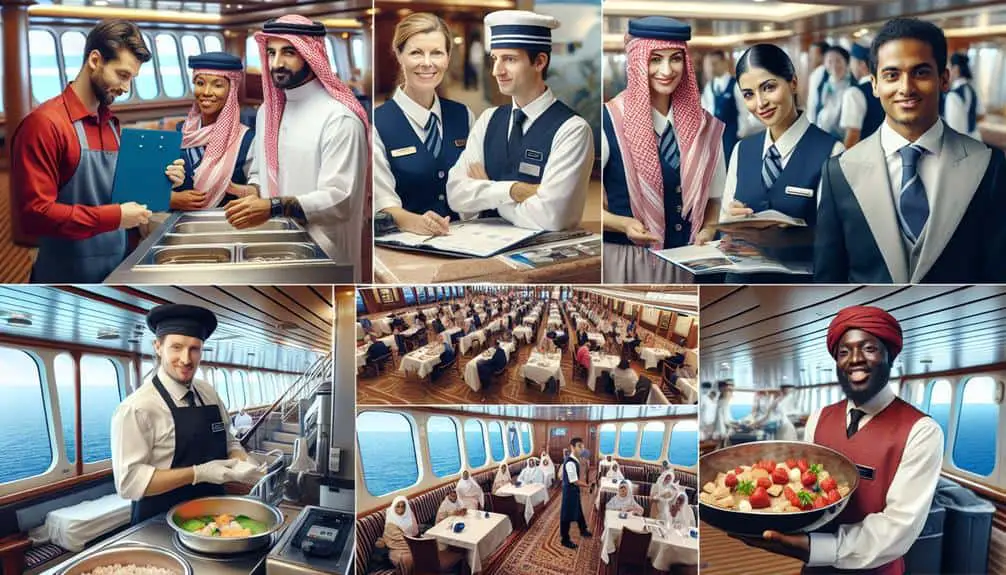As a cruise ship crew member, manage your workload by planning strategically and prioritizing tasks. Utilize time efficiently with designated break times and the Pomodoro Technique. Foster social connections with colleagues through engaging in onboard activities and building support systems. Deal with conflicts calmly, set boundaries, and uphold professionalism. Understand emergency protocols, communicate effectively during crises, and participate in drills for readiness. Establish personal space boundaries, communicate effectively, and respect others' space. Embrace cultural sensitivity by being adaptable, using clear communication, and learning basic greetings. Prevent burnout through self-care practices and utilizing mental health support. Master these tips to excel at sea.
Key Points
- Prioritize tasks and utilize the Pomodoro Technique for productivity.
- Engage in onboard activities for social connection and well-being.
- Manage conflicts peacefully and uphold customer service standards.
- Participate in emergency drills to ensure crew readiness.
- Respect personal space and communicate needs effectively.
Long Hours and Workload
Managing long hours and workload on a cruise ship requires strategic planning and effective time management techniques. To maintain work-life balance and prevent burnout, implementing coping mechanisms is vital. Begin by creating a detailed schedule that includes designated break times to rest and recharge. Prioritize tasks based on urgency and importance, allowing you to focus on critical duties first while managing stress levels effectively.
Utilize time management strategies such as the Pomodoro Technique, breaking work into intervals with short breaks in between to enhance productivity. Delegate tasks when possible to lighten your workload and collaborate with colleagues to streamline processes. Engaging in stress-relief activities like exercise, mindfulness, or hobbies during off-duty hours can have a significant impact on your overall well-being.
Establishing boundaries between work and personal time is essential to prevent overexertion. Communicate your needs to supervisors and colleagues, advocating for a healthy work environment. By integrating these practices into your daily routine, you can navigate the demanding hours and workload on a cruise ship efficiently while safeguarding your mental and physical health.
Isolation and Homesickness
To combat feelings of isolation and homesickness on a cruise ship, it's important to proactively engage with your surroundings and build connections with fellow crew members. Coping mechanisms play a crucial role in maintaining mental health and well-being while working in an isolated environment. Establishing support systems among colleagues can greatly alleviate the challenges of being away from home.
One effective strategy is to participate in onboard activities or social events. Engaging in group outings, team sports, or shared meals can foster a sense of belonging and camaraderie. Additionally, making an effort to communicate openly with coworkers can provide a valuable support network when feeling homesick.
Wellness strategies, such as maintaining a healthy lifestyle through regular exercise and balanced nutrition, can also help combat feelings of isolation. Physical activity can boost mood and reduce stress, contributing to overall mental well-being.
Dealing With Difficult Passengers
When dealing with difficult passengers on a cruise ship, it's important to manage rude behavior effectively.
You should aim to resolve conflicts peacefully and maintain a professional demeanor at all times.
Setting clear boundaries can help establish expectations and prevent further issues from escalating.
Managing Rude Behavior
Dealing with difficult passengers requires patience, effective communication, and a proactive approach. When managing rude behavior onboard, conflict resolution skills are paramount. Start by staying calm and composed, even in challenging situations.
Practice emotional intelligence by empathizing with the passenger's concerns while setting clear boundaries for acceptable behavior. Use active listening to understand the root of their rudeness and address it professionally. If necessary, involve a supervisor or security discreetly to prevent escalation.
Maintain a professional demeanor and avoid taking rude behavior personally. By addressing rudeness with a combination of conflict resolution techniques and emotional intelligence, you can navigate challenging interactions with difficult passengers effectively while upholding the standards of customer service onboard.
Resolving Conflicts Peacefully
Handling conflicts with challenging passengers on a cruise ship demands a blend of empathy, assertiveness, and strategic communication. When faced with difficult situations, resort to conflict resolution and mediation techniques to guarantee smooth sailing for all onboard.
Here are three key strategies to help you navigate conflicts with passengers effectively:
- Active Listening: Pay close attention to the passenger's concerns and emotions to show empathy and understanding.
- Maintain Calmness: Stay composed and avoid reacting impulsively to de-escalate tense situations.
- Offer Solutions: Collaborate with the passenger to find a mutually agreeable resolution, demonstrating your commitment to resolving the conflict peacefully.
Setting Clear Boundaries
To manage difficult passengers effectively, establish clear boundaries from the outset to prevent misunderstandings and maintain order onboard the cruise ship. Vital boundaries are essential to guarantee that passengers understand the limits and expectations of their behavior while aboard. Clearly communicate rules regarding interaction with crew members, respecting personal space, and following ship protocols.
When dealing with challenging individuals, calmly but firmly reinforce these boundaries to uphold a harmonious environment for all passengers and crew. Remember to prioritize your personal time to recharge and avoid burnout. Setting aside moments for self-care is key in maintaining your well-being and professionalism when faced with demanding situations.
Safety and Emergency Procedures
When it comes to ensuring the safety of all passengers and crew on board, understanding the importance of emergency drills is crucial.
Effective communication during crises can make a significant difference in handling emergency situations efficiently.
Being prepared and knowledgeable about safety and emergency procedures can help you respond promptly and effectively in times of need.
Emergency Drills Importance
Implementing regular emergency drills is essential for ensuring the safety and readiness of cruise ship crew members in handling potential emergencies effectively. Safety drills and emergency preparedness measures are fundamental components of crew training to mitigate risks and protect passengers. Here are three key reasons why emergency drills are of utmost importance:
- Familiarity with Procedures: Regular drills help crew members become acquainted with emergency protocols, ensuring quick and efficient responses during actual crises.
- Team Coordination: Practice fosters teamwork and coordination among crew members, enabling them to work seamlessly together in high-stress situations.
- Identifying Weaknesses: Conducting drills allows for the identification of weaknesses in emergency procedures, enabling crews to address and improve them before a real emergency occurs.
Communication During Crises
Regular emergency drills not only improve crew members' familiarity with procedures but also play a critical role in guaranteeing effective communication during crises on a cruise ship. Crisis communication is paramount during emergencies, necessitating seamless teamwork and clear directives to safeguard the safety of all passengers and crew.
Effective communication channels must be established, including regular updates, clear instructions, and feedback loops to address evolving situations promptly. Support systems for mental health should also be in place, acknowledging the stress and pressure that can arise during emergencies.
Crew members must be trained to remain calm, prioritize tasks, and work together efficiently to navigate through challenging situations. By fostering a culture of open communication and preparedness, cruise ship crews can effectively manage crises and ensure the well-being of everyone on board.
Limited Personal Space
Maintaining your personal space on a cruise ship can be challenging due to the confined living quarters and shared facilities. To navigate this issue effectively, consider the following tips:
- Establish Boundaries: Clearly communicate your need for personal space to your cabinmates. Agree on basic rules to respect each other's privacy and downtime.
- Organize Your Cabin: Make the most out of the limited space by keeping your belongings organized and stored away neatly. This will help create a sense of personal space within your cabin.
- Utilize Common Areas Strategically: Since personal space in cabins is limited, identify quiet spots around the ship where you can relax or unwind when you need some time alone. This can help alleviate feelings of being constantly surrounded by others.
Cultural Differences and Communication
Managing cultural differences and communication on a cruise ship can present unique challenges that require adaptability and understanding from all individuals aboard. Language barriers and cultural misunderstandings can arise when crew members and passengers come from diverse backgrounds. To navigate these challenges effectively, it's essential to be aware of the potential for misinterpretations and to approach interactions with sensitivity and an open mind.
Nonverbal communication and social cues play a significant role in effective communication on a cruise ship. Different cultures may have varying norms regarding personal space, eye contact, gestures, and tone of voice. Paying attention to these cues can help prevent misunderstandings and foster positive interactions among crew members and passengers.
To overcome language barriers, utilizing simple and clear language, using visual aids when possible, and being patient can facilitate better communication. Additionally, taking the time to learn basic greetings and phrases in the languages commonly spoken by passengers can go a long way in bridging communication gaps and showing respect for different cultures. By being mindful of cultural differences and communication cues, cruise ship crew members can create a more inclusive and harmonious environment onboard.
Burnout and Mental Health
Sailing through the challenging work environment of a cruise ship can greatly influence crew members' well-being and mental health. To combat burnout and prioritize mental wellness, it's important to implement self-care practices and utilize available support systems and mental health resources:
- Self-care practices and coping mechanisms:
Establish a routine that includes time for relaxation, exercise, and hobbies. Engage in mindfulness activities like meditation or yoga to alleviate stress. Make sure you get enough rest and maintain a healthy diet to support your overall well-being.
- Support systems and mental health resources:
Familiarize yourself with the mental health resources provided by the cruise line, such as counseling services or employee assistance programs. Build a support network among your colleagues to share experiences and provide mutual support. Don't hesitate to reach out to mental health professionals if you're struggling – seeking help is a sign of strength.
Frequently Asked Questions
How Do Cruise Ship Crew Members Handle Medical Emergencies on Board?
During medical emergencies on board, cruise ship crew members swiftly execute emergency response protocols, coordinating with medical staff and employing clear communication to guarantee a seamless medical evacuation when necessary. Safety and efficiency are paramount.
What Training Do Crew Members Receive to Deal With Extreme Weather Conditions While at Sea?
As a cruise ship crew member, you undergo rigorous training protocols to handle extreme weather conditions at sea. Safety measures include emergency drills, weather monitoring, navigation adjustments, and communication protocols to guarantee preparedness and passenger well-being.
When interacting with passengers from diverse backgrounds, you navigate language barriers through cultural etiquette and utilize translation services. Understanding customs and utilizing tools guarantees effective communication, enhancing guest experience and fostering a welcoming environment on board.
Are There Specific Protocols in Place for Handling Lost or Stolen Personal Belongings While Working on a Cruise Ship?
When items go missing on a cruise ship, follow specific reporting procedures to document the incident. Security measures include surveillance footage reviews. Prevention techniques involve securing personal belongings. Compensation may vary based on the situation and policies in place.
How Do Crew Members Stay Connected With Their Families and Loved Ones While Away for Long Periods of Time?
To stay connected while at sea, crew members often use onboard Wi-Fi, messaging apps, and scheduled calls. Prioritizing regular communication with loved ones is essential for mental health awareness and maintaining strong relationships during long periods away from home.




